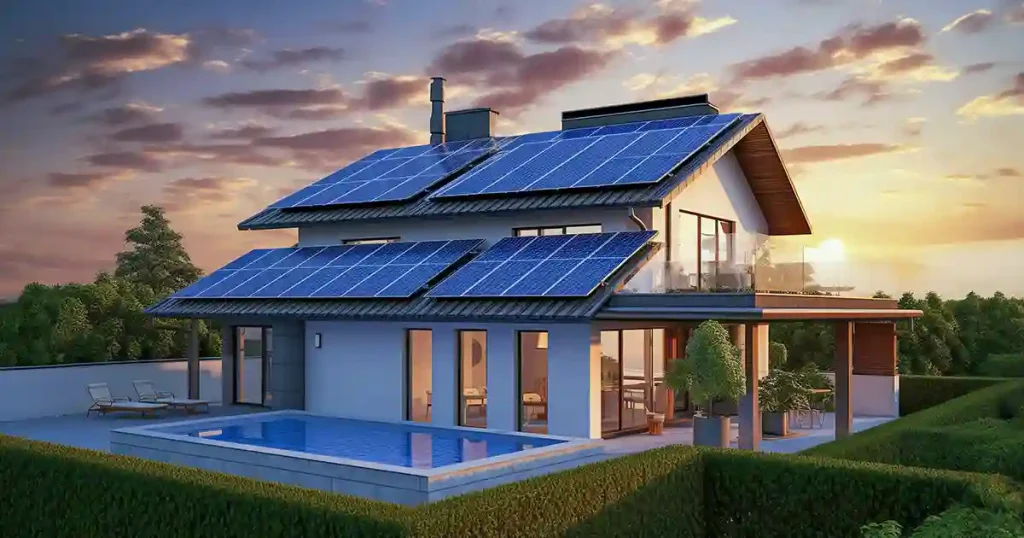Solar energy has emerged as one of the most sustainable and efficient sources of renewable energy, transforming how we power our homes and businesses. While traditional solar panels have been around for decades, smart solar panels represent the next evolution in solar technology, offering advanced features that optimize energy production and management. Let’s explore the key differences between traditional and smart solar panels to understand what makes smart solar systems a game-changer in the energy landscape.
1. Basic Functionality
- Traditional Solar Panels
Traditional solar panels convert sunlight into direct current (DC) electricity. This energy is typically passed through an inverter, which converts it into alternating current (AC) for use in homes or businesses. The energy produced depends on the amount of sunlight and the efficiency of the panel itself. - Smart Solar Panels
Smart solar panels go beyond basic energy conversion. They are equipped with microinverters or power optimizers that improve energy efficiency and allow each panel to operate independently. This results in better energy output, especially in areas with partial shading or non-ideal sunlight conditions.
2. Energy Efficiency and Output
- Traditional Solar Panels
In a traditional solar panel setup, panels are wired in series. This means that if one panel is shaded or malfunctioning, it affects the performance of the entire system. Consequently, energy production is often less efficient, especially in environments where shading or cloud cover is common. - Smart Solar Panels
Smart panels solve this problem by using built-in technology like microinverters or DC optimizers to ensure each panel operates independently. This enables higher energy efficiency since a shaded or poorly performing panel won’t drag down the performance of others. The system can maximize output even in less-than-ideal conditions.
3. Monitoring and Control
- Traditional Solar Panels
Traditional solar systems typically don’t come with sophisticated monitoring systems. Homeowners might not know how each panel is performing unless there’s a significant drop in overall energy output. Identifying issues like damage or dirt buildup on a panel can be challenging without regular inspections. - Smart Solar Panels
Smart panels are often integrated with real-time monitoring systems that allow users to track energy production, consumption, and even individual panel performance from their smartphones or computers. This real-time feedback enables quick problem detection, system optimization, and more efficient energy management.
4. Installation and Maintenance
- Traditional Solar Panels
The installation of traditional solar panels is relatively straightforward, but since the system operates as a whole, maintenance can be more time-consuming. A single malfunctioning panel can reduce the entire system’s output, and troubleshooting can require examining each panel. - Smart Solar Panels
Smart solar panels may require slightly more complex installation because of the additional components, such as microinverters and advanced wiring. However, they significantly reduce long-term maintenance needs. The system’s self-monitoring capabilities alert users to issues, making troubleshooting faster and more precise.
5. Scalability and Flexibility
- Traditional Solar Panels
When expanding a traditional solar system, adding more panels can sometimes be challenging due to the need for a balanced system. New panels must be similar in size and output to the existing ones, or the system’s efficiency could drop. - Smart Solar Panels
Smart systems offer greater flexibility when it comes to scalability. Since each panel operates independently, new panels can be easily added, even if they have different wattages or are positioned at different angles. This makes it simpler for homeowners and businesses to scale up their solar systems over time.
6. Cost
- Traditional Solar Panels
Traditional solar panels are generally more affordable upfront. However, lower efficiency, lack of real-time monitoring, and potential energy losses due to shading can lead to longer payback periods. - Smart Solar Panels
Smart solar panels tend to have a higher initial cost due to the integration of advanced technologies like microinverters and monitoring systems. However, they offer greater energy efficiency and optimization, resulting in a faster return on investment and more savings over the system’s lifetime.
7. Energy Storage and Grid Integration
- Traditional Solar Panels
Traditional solar systems are often designed to supply power directly to the grid or a simple storage system like a solar battery. They typically lack sophisticated energy management features, which can make balancing energy production and consumption less efficient. - Smart Solar Panels
Smart panels are often paired with smart energy storage systems, allowing users to store excess energy and manage when and how it is used. These systems can automatically switch between grid power, battery storage, and direct solar energy, optimizing cost savings and energy independence.
Conclusion
While traditional solar panels have been effective in helping homes and businesses transition to renewable energy, smart solar panels represent a significant leap forward. Their enhanced efficiency, monitoring capabilities, and flexibility make them a better option for those looking to maximize their energy production and lower long-term costs. As solar technology continues to advance, smart solar panels are paving the way for a more intelligent and responsive renewable energy future. Whether you’re considering solar for your home or business, the shift to smart solar panels is an investment in both technology and sustainability.

